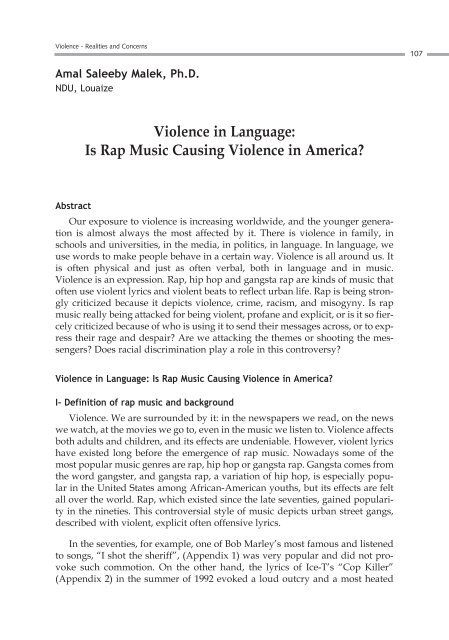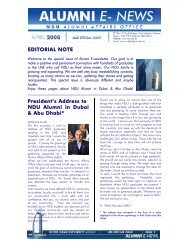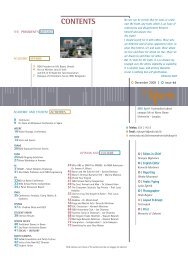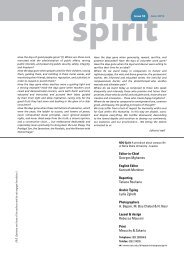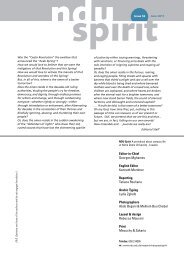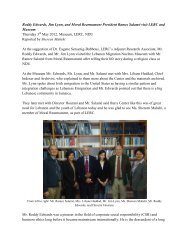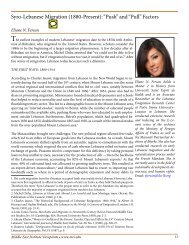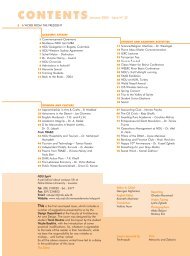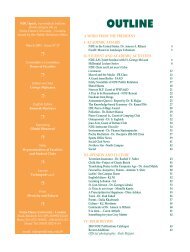Violence in Language: Is Rap Music Causing Violence in America?
Violence in Language: Is Rap Music Causing Violence in America?
Violence in Language: Is Rap Music Causing Violence in America?
You also want an ePaper? Increase the reach of your titles
YUMPU automatically turns print PDFs into web optimized ePapers that Google loves.
<strong>Violence</strong> - Realities and Concerns<br />
Amal Saleeby Malek, Ph.D.<br />
NDU, Louaize<br />
<strong>Violence</strong> <strong>in</strong> <strong>Language</strong>:<br />
<strong>Is</strong> <strong>Rap</strong> <strong>Music</strong> Caus<strong>in</strong>g <strong>Violence</strong> <strong>in</strong> <strong>America</strong>?<br />
Abstract<br />
Our exposure to violence is <strong>in</strong>creas<strong>in</strong>g worldwide, and the younger generation<br />
is almost always the most affected by it. There is violence <strong>in</strong> family, <strong>in</strong><br />
schools and universities, <strong>in</strong> the media, <strong>in</strong> politics, <strong>in</strong> language. In language, we<br />
use words to make people behave <strong>in</strong> a certa<strong>in</strong> way. <strong>Violence</strong> is all around us. It<br />
is often physical and just as often verbal, both <strong>in</strong> language and <strong>in</strong> music.<br />
<strong>Violence</strong> is an expression. <strong>Rap</strong>, hip hop and gangsta rap are k<strong>in</strong>ds of music that<br />
often use violent lyrics and violent beats to reflect urban life. <strong>Rap</strong> is be<strong>in</strong>g strongly<br />
criticized because it depicts violence, crime, racism, and misogyny. <strong>Is</strong> rap<br />
music really be<strong>in</strong>g attacked for be<strong>in</strong>g violent, profane and explicit, or is it so fiercely<br />
criticized because of who is us<strong>in</strong>g it to send their messages across, or to express<br />
their rage and despair? Are we attack<strong>in</strong>g the themes or shoot<strong>in</strong>g the messengers?<br />
Does racial discrim<strong>in</strong>ation play a role <strong>in</strong> this controversy?<br />
<strong>Violence</strong> <strong>in</strong> <strong>Language</strong>: <strong>Is</strong> <strong>Rap</strong> <strong>Music</strong> Caus<strong>in</strong>g <strong>Violence</strong> <strong>in</strong> <strong>America</strong>?<br />
I- Def<strong>in</strong>ition of rap music and background<br />
<strong>Violence</strong>. We are surrounded by it: <strong>in</strong> the newspapers we read, on the news<br />
we watch, at the movies we go to, even <strong>in</strong> the music we listen to. <strong>Violence</strong> affects<br />
both adults and children, and its effects are undeniable. However, violent lyrics<br />
have existed long before the emergence of rap music. Nowadays some of the<br />
most popular music genres are rap, hip hop or gangsta rap. Gangsta comes from<br />
the word gangster, and gangsta rap, a variation of hip hop, is especially popular<br />
<strong>in</strong> the United States among African-<strong>America</strong>n youths, but its effects are felt<br />
all over the world. <strong>Rap</strong>, which existed s<strong>in</strong>ce the late seventies, ga<strong>in</strong>ed popularity<br />
<strong>in</strong> the n<strong>in</strong>eties. This controversial style of music depicts urban street gangs,<br />
described with violent, explicit often offensive lyrics.<br />
In the seventies, for example, one of Bob Marley’s most famous and listened<br />
to songs, “I shot the sheriff”, (Appendix 1) was very popular and did not provoke<br />
such commotion. On the other hand, the lyrics of Ice-T’s “Cop Killer”<br />
(Appendix 2) <strong>in</strong> the summer of 1992 evoked a loud outcry and a most heated<br />
107
108<br />
Dr. Amal Saleeby Malek<br />
debate about whether ideas about kill<strong>in</strong>g police officers should be expressed<br />
publicly (Siev<strong>in</strong>g, 1998).<br />
<strong>Violence</strong> seems to dom<strong>in</strong>ate much of our daily conversations. We often express<br />
ourselves by curs<strong>in</strong>g or <strong>in</strong>sult<strong>in</strong>g people around us. Verbal violence occurs<br />
as a “normal” way of talk<strong>in</strong>g. Similarly, the lyrics of some rap songs use foul language,<br />
such as the F… word, a “bonafide” word <strong>in</strong> the English language.<br />
(Appendix 2)<br />
Moreover, the explicit lyrics <strong>in</strong> some rap songs highlight drugs, sex, misogyny,<br />
promiscuity, racism, and crime. “Have you ever been hated or discrim<strong>in</strong>ated<br />
aga<strong>in</strong>st? I have; I’ve been protested and demonstrated aga<strong>in</strong>st”, says<br />
Em<strong>in</strong>em <strong>in</strong> his “Clean<strong>in</strong> Out the Closet” album (Appendix 3). It would seem that<br />
violent behavior is part of the process of search<strong>in</strong>g for one’s <strong>in</strong>dividual or collective<br />
identity (UNESCO, <strong>Language</strong> as violence). Could this be what rappers<br />
do? However, some rap artists adopt friendlier beats and milder lyrics.<br />
Most rappers claim that they are illustrat<strong>in</strong>g the real <strong>in</strong>ner-city life although<br />
they may not necessarily endorse it, much like an actor adopt<strong>in</strong>g a role <strong>in</strong> a<br />
movie. This form of music is stereotypical of African-<strong>America</strong>ns and aims to<br />
enterta<strong>in</strong>. Many rap themes deal with street life <strong>in</strong>clud<strong>in</strong>g pimp<strong>in</strong>g, and hustl<strong>in</strong>g<br />
as well as kill<strong>in</strong>g and shoot<strong>in</strong>g. Some musicians refer to their gang or pistol and<br />
one can hear rough beats along with actual gunshots <strong>in</strong> the songs. RunDMC, a<br />
rap group dresses <strong>in</strong> gang-like street cloth<strong>in</strong>g, displays abrasive attitudes and<br />
uses foul language to send across their message. Schooly D, Ice Cube and Nas<br />
are other rappers who adopt the same style. They have popularized “hard-hitt<strong>in</strong>g,<br />
aggressive, often socio-political lyrics, sometimes revolv<strong>in</strong>g around street<br />
violence, poverty, and gunplay” (Gangsta rap). There are many references to<br />
guns and pimp<strong>in</strong>g <strong>in</strong> these songs. Boogie Down Productions released CDs describ<strong>in</strong>g<br />
“shoot<strong>in</strong>g rival weed dealers after they try to kill [someone] <strong>in</strong> his home”<br />
(Gangsta rap).<br />
An album entitled Crim<strong>in</strong>al M<strong>in</strong>ded was released <strong>in</strong> 1987. After the release<br />
of the album, the DJ, “Scott LaRock was shot and killed” (Gangsta rap). In 1986,<br />
N.W.A., a rap group, released their first album, which <strong>in</strong>troduced more violent<br />
lyrics and rougher musical beats. The first major controversy was sparked regard<strong>in</strong>g<br />
hip-hop lyrics <strong>in</strong> their song, “F—- Tha Police”. The FBI sent a letter strongly<br />
condemn<strong>in</strong>g the song. Other West Coast rappers began to use crime-related<br />
themes <strong>in</strong> their lyrics (Gangsta rap).<br />
The controversy and the “hype” over the rap lyrics attracted a lot of media<br />
attention. Ice T’s releases <strong>in</strong> 1993 conta<strong>in</strong>ed political material, “Bomb-Squad<br />
style beats” and he even went on to publish a book: The Ice Op<strong>in</strong>ion: Who Gives<br />
a F—-?” (Gangsta rap). Dr. Dre and Tupac Shakur very successful and <strong>in</strong>fluential<br />
West coast hip hop artists created Death Row Records, and East coast rap-
<strong>Violence</strong> - Realities and Concerns<br />
pers, released Bad Boys Records, featur<strong>in</strong>g a song entitled “Ready to Die” <strong>in</strong><br />
1994. It is widely suggested that the battle between the two companies resulted<br />
<strong>in</strong> the deaths of Tupac Shakur, of Death Row, <strong>in</strong> 1996, and the Notorious B.I.G.<br />
of Bad Boy’s <strong>in</strong> 1997.<br />
Meanwhile Southern and Midwestern gangsta rap cont<strong>in</strong>ued to flourish with<br />
Scarface, a famous rapper, and <strong>in</strong> New Orleans, Master P’s added a new release.<br />
“The Ghetto is try<strong>in</strong>g to kill me” <strong>in</strong> 1994 (Gangsta rap).<br />
II- <strong>Is</strong> rap music more violent than other genres: Western movies?<br />
<strong>Rap</strong> is not the only rebellious music that has been blamed for society’s ills.<br />
<strong>Music</strong>al genres (reggae and others) have often been blamed for socially <strong>in</strong>appropriate<br />
behavior. However, violent and sexually explicit gangsta rap has raised<br />
significant concern (Kirshheimer, 2003). <strong>Is</strong> it because it criticizes social <strong>in</strong>justice<br />
and puts the blame on a deficient system?<br />
Movies are one way we enterta<strong>in</strong> ourselves. Western movies are engra<strong>in</strong>ed<br />
<strong>in</strong> the <strong>America</strong>n public’s m<strong>in</strong>d. They are part of the <strong>America</strong>n culture. Western<br />
“cowboys” and “Indians” movies are all about “saloons, shotguns, and showdowns”<br />
(Carter, 2002). But, the <strong>America</strong>n public associates “The Myth of the<br />
West” to <strong>America</strong>n pride, and sees the violence <strong>in</strong> those movies as a sign of<br />
valor. Actors such as Cl<strong>in</strong>t Eastwood, John Ford and Gary Cooper, are famous<br />
for shoot<strong>in</strong>g Indians and no one would th<strong>in</strong>k of condemn<strong>in</strong>g them for their violent<br />
scenes; and, John Wayne always won, <strong>in</strong> tak<strong>in</strong>g land from the Indians.<br />
Cowboy movies are not censored nor criticized; they are accepted as part of the<br />
<strong>America</strong>n values, and are deeply respected and appreciated. In Western movies,<br />
the public cheers with the hero’s violent response to various situations (Carter,<br />
2002).<br />
Nowadays, movies are more and more violent, from Pulp Fiction to Blood<br />
Diamond, not forgett<strong>in</strong>g the Last K<strong>in</strong>g of Scotland, just to name a few; however,<br />
there does not seem to be any agitation or mental anguish about those movies.<br />
So, “…what makes the violence <strong>in</strong> gangsta rap music more violent than the<br />
bloodshed <strong>America</strong>ns applaud <strong>in</strong> Westerns”? (Carter, 2002). One may wonder,<br />
is it because the rappers are mostly African-<strong>America</strong>n <strong>in</strong> a white ma<strong>in</strong>stream<br />
<strong>America</strong>? Or, is it because music is more pervasive than a movie? (It may be<br />
more difficult to control what people listen to; youngsters, for <strong>in</strong>stance, can listen<br />
to any k<strong>in</strong>d of music, without parental supervision, whereas movies, which<br />
are usually rated, need parental guidance). <strong>Is</strong> it the <strong>in</strong>ability to relate to “the feel<strong>in</strong>gs<br />
of these angry, black cowboys try<strong>in</strong>g to survive <strong>in</strong> the modern Wild Wild<br />
West”? <strong>Is</strong> it because white <strong>America</strong> cannot identify with the black” socio-economic<br />
conditions”, and “the harsh liv<strong>in</strong>g conditions of these rappers?” (Carter,<br />
2002).<br />
109
110<br />
Dr. Amal Saleeby Malek<br />
Society reacts to rap themes with fury and condemnation; however, the plots<br />
and devices <strong>in</strong> Western movies are not less violent or profane.<br />
In addition to criticiz<strong>in</strong>g the violent lyrics <strong>in</strong> rap, rap is criticized because rappers<br />
are known to “s<strong>in</strong>g of guns with almost lascivious glee”. They talk about<br />
their “pieces” or “glocks”, “n<strong>in</strong>as” or pistols as “the object of their affections”.<br />
(Nordl<strong>in</strong>ger, 2001). The rapper Notorious B.I.G. says: “Somebody’s gotta die.<br />
Let the gunshots blow…Give them bullets room to breathe” (Appendix 4).<br />
It is obvious that, contrary to their objections, <strong>America</strong>ns have shown that<br />
violence as a theme is not the problem, s<strong>in</strong>ce it is so well received and even<br />
appreciated as a great moral value <strong>in</strong> Western movies. So, what is the real reason<br />
for their condemnation?<br />
I agree with Keonna Carter, when she says that rap music is be<strong>in</strong>g criticized,<br />
not because it is too violent, too explicit or too offensive, but because of who is<br />
us<strong>in</strong>g it as a medium. (2002). If violence is to be considered a threat to society,<br />
then she says, it “should be consistently def<strong>in</strong>ed along non-racial l<strong>in</strong>es” (Carter,<br />
2002). Violent language deal<strong>in</strong>g with crime, death, sex, drugs, profanity, should<br />
be condemned regardless of who is express<strong>in</strong>g it.<br />
III- Can violence be blamed on rap music?<br />
<strong>Rap</strong> music is the black community shar<strong>in</strong>g their culture and tell<strong>in</strong>g their stories<br />
<strong>in</strong> their own special way. For example, “Runaway Love’ is a powerful song<br />
demonstrat<strong>in</strong>g the plight of three, n<strong>in</strong>e, ten and eleven- year old girls who are<br />
“forced to th<strong>in</strong>k that hell is a place called home” (Appendix 5). The song tells<br />
stories of drugs, rape, prostitution, hunger, abuse and lost childhood. This<br />
shows how the violence and pa<strong>in</strong> <strong>in</strong> rap music “is merely a reflection of the violence<br />
that many urban dwellers deal with daily <strong>in</strong> <strong>America</strong>”. What should be<br />
addressed are “the true problems that grip urban <strong>America</strong>n cities”. (Should<br />
Gangsta <strong>Rap</strong> Take the Blame for <strong>Violence</strong> <strong>in</strong> <strong>America</strong>?).<br />
Thus, rap is not only music; it is a story. <strong>Rap</strong> music illustrates “life <strong>in</strong> the<br />
hood”, and portrays the rappers true experiences and feel<strong>in</strong>gs. It depicts poverty<br />
and homelessness, unemployment, and destitution, gang ties and cruelty,<br />
bad, violent, home life and feel<strong>in</strong>gs of be<strong>in</strong>g persecuted by the police. <strong>Rap</strong>pers<br />
and members of their communities have to deal with these issues everyday of<br />
their lives. This is not an imag<strong>in</strong>ed or imag<strong>in</strong>ary world they fantasize about, this<br />
is their everyday reality. Through their songs, rappers have been demonstrat<strong>in</strong>g<br />
what goes on <strong>in</strong> their lives, the misery they experience and the despair they feel<br />
when they th<strong>in</strong>k about suicide and about hav<strong>in</strong>g a worthless future (Poggioli,<br />
2005).
<strong>Violence</strong> - Realities and Concerns<br />
If this reality (the conditions <strong>in</strong> which rappers live) is dealt with, then rap, as<br />
an art form or expression will naturally cease to exist the way we know it, and<br />
a gentler more perfect art form will emerge to depict the new realities of life.<br />
If we agree that “art imitates nature”, we realize that rap music illustrates<br />
“some of the most complex social, cultural and political issues <strong>in</strong> contemporary<br />
<strong>America</strong>n society”. (Should Gangsta <strong>Rap</strong> Take the Blame for <strong>Violence</strong> <strong>in</strong><br />
<strong>America</strong>?). <strong>Rap</strong>pers usually live <strong>in</strong> the <strong>America</strong>n ghetto, which is characteristic<br />
of poverty, violence, crime, “the ugly reality of the streets”. For many young<br />
black youths, this k<strong>in</strong>d of music “is the only way to escape from the pa<strong>in</strong> <strong>in</strong><br />
which they live”. (Should Gangsta <strong>Rap</strong> Take the Blame for <strong>Violence</strong> <strong>in</strong><br />
<strong>America</strong>?) It is a lament, a cry for help, a way to vent their frustrations. <strong>Rap</strong><br />
music “pa<strong>in</strong>ts an ugly picture” of their daily life, but when audiences hear their<br />
idealized or idolized artists experience their pa<strong>in</strong> and identify with their plight,<br />
it becomes more bearable for the rappers to deal with their situations and more<br />
possible for them to hope for a better future.<br />
These are the real issues that should be dealt with. The source of the problem<br />
should be the ma<strong>in</strong> concern, not the manner <strong>in</strong> which the issue is expressed <strong>in</strong><br />
songs. It is said that language and culture go hand <strong>in</strong> hand, and words should<br />
be understood <strong>in</strong> their context. Words are sometimes used to make people behave<br />
<strong>in</strong> a certa<strong>in</strong> way. It may be that this is what lyrics and other literary expressions<br />
attempt to do. <strong>Rap</strong>per, Ice-T expla<strong>in</strong>s for <strong>in</strong>stance, that with<strong>in</strong> his community,<br />
rap is considered “verbal combat” (Siev<strong>in</strong>g, 1998). The “fight<strong>in</strong>g words”<br />
illustrate “angry verbal disputes”, sometimes <strong>in</strong>clud<strong>in</strong>g “<strong>in</strong>sults and threats”.<br />
Thomas Kockman (1981) <strong>in</strong> his book Black and White Styles <strong>in</strong> Conflict, expla<strong>in</strong>s<br />
“fight<strong>in</strong>g words” and says that violent language among blacks “can be ma<strong>in</strong>ta<strong>in</strong>ed<br />
by blacks at the verbal level without violence necessarily result<strong>in</strong>g” (<strong>in</strong><br />
Siev<strong>in</strong>g, 1998).<br />
<strong>Rap</strong> is certa<strong>in</strong>ly not understood by everyone. It is not a familiar art form,<br />
which may be one of the reasons it is feared and perceived as a threat. Thus,<br />
when rap is labeled as evil and as <strong>in</strong>cit<strong>in</strong>g violence, it is mostly ignorance that is<br />
at play. <strong>Rap</strong> should not be considered a cause of violence.<br />
<strong>Rap</strong> talks about violence, lays it out <strong>in</strong> the open, is not shy about expos<strong>in</strong>g it,<br />
is explicit and raunchy, but by no means does it create violence. When teenagers<br />
listen to violent rap lyrics, evidently they may be attracted to them, or want to<br />
imitate them, without know<strong>in</strong>g the reason beh<strong>in</strong>d the words. This is why their<br />
parents object to the lyrics. But merely listen<strong>in</strong>g to foul or offensive language<br />
does not mean that we will become offensive and violent ourselves.<br />
What the parents can do is expla<strong>in</strong> the bad conditions <strong>in</strong> which many of the<br />
rappers live and thus, give the children a more comprehensive and educated<br />
perspective on the issues at hand. This is not to say that parents are to condone<br />
111
112<br />
Dr. Amal Saleeby Malek<br />
the violent language, but to try to expla<strong>in</strong> the reasons beh<strong>in</strong>d it so as to show the<br />
youngsters a clearer, more realistic picture of the world they live <strong>in</strong>. It should be<br />
the parents’ responsibility to guide their children and monitor what they watch<br />
and/or listen to.<br />
On the other hand, teenagers should realize that we live <strong>in</strong> an imperfect<br />
world; hid<strong>in</strong>g the truth from them does not help them. Teens must realize that<br />
there is <strong>in</strong>justice and imbalance <strong>in</strong> the world, which some rap music deals with.<br />
<strong>Is</strong>sues such as police brutality and racial discrim<strong>in</strong>ation are depicted <strong>in</strong> rap<br />
music. What society must do is try to improve everyday realities <strong>in</strong> order to<br />
create a better world for the future generations.<br />
On the positive side, it is worth mention<strong>in</strong>g that rappers are often young men<br />
mostly raised <strong>in</strong> humble homes, who have tremendous talent and who through<br />
hard work have made a place for themselves <strong>in</strong> the society. Their creativity and<br />
talent, <strong>in</strong> addition to their hard work and dedication are part of the <strong>America</strong>n<br />
dream. All rap music is not about violence and foul language. Some rappers s<strong>in</strong>g<br />
about love, like NB Rudaz, and others (Appendix 6).<br />
It is unfortunate that the death of Tupac Shakur is blamed on rap violence.<br />
Tupac lived <strong>in</strong> the slums, where he developed a “negative outlook on life”, but<br />
he also had many positive views. In his own words, Tupac wanted to “heal”<br />
people and admitted his troubles but never asked anyone to follow his bad<br />
example. Like many other rappers he admits to mak<strong>in</strong>g mistakes but tells his<br />
public to pay attention and learn from their mistakes. (Should Gangsta <strong>Rap</strong> Take<br />
the Blame for <strong>Violence</strong> <strong>in</strong> <strong>America</strong>?). It should also be remembered that rappers,<br />
although they may become role models to teenagers, are first and foremost<br />
enterta<strong>in</strong>ment artists, not moralists. Their job is to enterta<strong>in</strong>, not to teach. Many<br />
rappers are perceived negatively and people tend to forget that they are play<strong>in</strong>g<br />
a role.<br />
Misconceptions aga<strong>in</strong>st rappers abound, and opponents of rap music should<br />
concentrate on positive personal statements <strong>in</strong>stead of violent lyrics <strong>in</strong> songs.<br />
<strong>Rap</strong>pers, after all, are “a product of a society” that, accord<strong>in</strong>g to Tupac Shakur,<br />
often tells them that their life is worthless. (Should Gangsta <strong>Rap</strong> Take the Blame<br />
for <strong>Violence</strong> <strong>in</strong> <strong>America</strong>?)<br />
As Tupac Shakur, says, “In any other country with any other sk<strong>in</strong> color, I<br />
would have been a great lawyer, like Tom Cruise <strong>in</strong> The Firm”. (Should Gangsta<br />
<strong>Rap</strong> Take the Blame for <strong>Violence</strong> <strong>in</strong> <strong>America</strong>?). Tupac blames <strong>America</strong> for depict<strong>in</strong>g<br />
him as a black cop-killer. His music is his way of react<strong>in</strong>g aga<strong>in</strong>st the system.<br />
As mentioned earlier, rappers often have positive messages. “Keep Ya<br />
Head Up” is a song for black women ask<strong>in</strong>g men to respect them. Another<br />
example is “One Nation” which was Tupac’s way of ask<strong>in</strong>g his fellow rappers
<strong>Violence</strong> - Realities and Concerns<br />
to unite and show the world a better black community. (Should Gangsta <strong>Rap</strong><br />
Take the Blame for <strong>Violence</strong> <strong>in</strong> <strong>America</strong>?)<br />
Accord<strong>in</strong>g to John Leland of Newsweek, the negative connotation that rappers<br />
acquire, cannot be avoided. However, urban violence, he warns, should not<br />
be blamed on rap. The problem is that many rappers come from poor, low-<strong>in</strong>come<br />
communities. This is the issue that must be addressed. Moreover, it is presumed<br />
that “violence is provoked by social shame”. Accord<strong>in</strong>g to a 1995 issue<br />
of Journal of Black Studies, people who are considered <strong>in</strong>ferior to others are<br />
more likely to become violent. (Should Gangsta <strong>Rap</strong> Take the Blame for <strong>Violence</strong><br />
<strong>in</strong> <strong>America</strong>.)<br />
That is why violence is high among poor blacks. <strong>Rap</strong> artists are mostly<br />
young, black and poor, which accounts for the high <strong>in</strong>cidence of violence <strong>in</strong> their<br />
songs. Some use it to make their audience “feel the pa<strong>in</strong>”, and others use fantasy<br />
<strong>in</strong>stead. And, certa<strong>in</strong>ly, express<strong>in</strong>g themselves <strong>in</strong> music is more desirable<br />
than tak<strong>in</strong>g it out on the streets.<br />
IV- Conclusion<br />
The l<strong>in</strong>k between rap lyrics and violence seems overrated. The claim that violent<br />
language causes violent behavior “is neither conv<strong>in</strong>c<strong>in</strong>g nor conclusive<br />
(United States Senate)”. Hip hop and rap are dist<strong>in</strong>ct forms of art like other<br />
types of music. The violent lyrics <strong>in</strong> the songs reflect the violence found <strong>in</strong> many<br />
<strong>America</strong>n cities, rather than create it. It is not only unfair but also naive to blame<br />
rap music for social violence (<strong>Violence</strong> <strong>in</strong> rap music).<br />
When Stevie Wonder was asked about his thoughts on rap, he said:” I learn<br />
from rap…Listen hard, and you’ll hear the pa<strong>in</strong>. Without feel<strong>in</strong>g the pa<strong>in</strong> yourself,<br />
you’ll never understand. And what we don’t understand, we can’t change,<br />
can’t heal. I hate it when the very folks who should be listen<strong>in</strong>g to rap are attack<strong>in</strong>g<br />
it so hard they miss the po<strong>in</strong>t. The po<strong>in</strong>t is that children and the neighborhoods-the<br />
whole country… is drown<strong>in</strong>g <strong>in</strong> violence” (Smitherman, 1997, <strong>in</strong><br />
Carter, 2002).<br />
So, hip-hop and rap music are rooted <strong>in</strong> violent, sexist and raunchy, profane<br />
themes; however, they should not be the only genres to be criticized or condemned.<br />
Violent movies and violence <strong>in</strong> the media have to be addressed as well.<br />
S<strong>in</strong>ce art mirrors life, whatever movie we watch or music we listen to is only<br />
depict<strong>in</strong>g this reality, it is not creat<strong>in</strong>g it. Although teens may be negatively<br />
affected by violence, violence exists everywhere, even <strong>in</strong> their homes, schools or<br />
work places. <strong>Rap</strong> music is not the only detrimental feature <strong>in</strong> their dysfunctional<br />
or imperfect world, and, should not be s<strong>in</strong>gled out as the only or the worst<br />
exist<strong>in</strong>g nightmare. Movies are often much more effective <strong>in</strong> depict<strong>in</strong>g violence,<br />
113
114<br />
Dr. Amal Saleeby Malek<br />
rapes and kill<strong>in</strong>gs, (a picture is worth one thousand words) and should be monitored<br />
as well.<br />
It is evident that we live <strong>in</strong> a culture of violence, and rap music is an art that<br />
reflects this reality. If we lived <strong>in</strong> a non-violent society, rap, the way we know it,<br />
would not exist. <strong>Rap</strong>, after all, is a form of enterta<strong>in</strong>ment. If a rapper is <strong>in</strong>volved<br />
<strong>in</strong> crime, it has to do with the <strong>in</strong>dividual himself, with his environment and<br />
upbr<strong>in</strong>g<strong>in</strong>g not with the fact that he is a rap artist. I agree with James Gilligan,<br />
M.D. when he says: “People make choices and decisions for themselves”.<br />
(Should Gangsta <strong>Rap</strong> Take the <strong>Violence</strong> <strong>in</strong> <strong>America</strong>?) People make their own<br />
choices, and if they s<strong>in</strong>g violent songs, it is because they themselves are violent,<br />
not only the songs they s<strong>in</strong>g. Thus, rap music should not be blamed for the decisions<br />
people make. S<strong>in</strong>ce rap music mirrors urban <strong>America</strong>n city life, the fight<br />
should be aga<strong>in</strong>st the causes of violence, not aga<strong>in</strong>st its effects. The rappers are<br />
not the ones caus<strong>in</strong>g the violence; they are merely talk<strong>in</strong>g about it.<br />
“It is far too simplistic to portray rap artists as perpetuators of behavior deemed<br />
socially deviant without plac<strong>in</strong>g the artists and their life experiences <strong>in</strong><br />
context” (Richardson & Scott, 2002). After all, we should be grateful that the<br />
artist is express<strong>in</strong>g his anger <strong>in</strong> a song, rather than on the streets. (Should<br />
Gangsta <strong>Rap</strong> take the Blame for <strong>Violence</strong> <strong>in</strong> <strong>America</strong>?)<br />
In conclusion, to say that rap music causes violence is a “misdiagnosis”.<br />
People concerned should look at the root of the problem and rap is only a symptom<br />
of this illness. <strong>Rap</strong> is one way <strong>in</strong> which people express themselves, and thus<br />
reflects a certa<strong>in</strong> economic and social aspect of reality. The answer to end<strong>in</strong>g<br />
gang violence is not <strong>in</strong> limit<strong>in</strong>g the artistic expression <strong>in</strong> rap music. Although it<br />
has an <strong>in</strong>fluence on the public who listens to it, rap is not the reason for society’s<br />
troubles. It is rather the consequence of those troubles. Those concerned<br />
should concentrate their efforts “on the oppression, poverty, and destitution<br />
that manifest themselves <strong>in</strong> urban lawlessness” (Dorn, 2003). Neither the artist,<br />
nor his art form should be blamed; let us not shoot the messenger!
<strong>Violence</strong> - Realities and Concerns<br />
References<br />
Carter, K. (June 2002) “<strong>Rap</strong>p<strong>in</strong>g it Up”.<br />
http://xroads.virg<strong>in</strong>ia.edu/~UG03/carter/rap/rapup/html Retrieved March<br />
16, 2007-03-20<br />
Dorn, D. (June 2003) “Gang <strong>Violence</strong> Spawns <strong>Rap</strong> <strong>Music</strong>”.<br />
http://media.www.thelantern.com/media/storage/paper333/news/2003/06<br />
/04/Op<strong>in</strong>ion/G... Retrieved March 15, 2007<br />
Example Essays.com “<strong>Violence</strong> <strong>in</strong> rap music”<br />
http://www.exampleessays.com/viepaper/4608.html Retrieved March 15,<br />
2007<br />
Kirchheimer, S.(March 2003) “Does <strong>Rap</strong> Put Teens at Risk?” WebMD Medical<br />
News. http://www.webmd.com/baby/news/20030303/does-rap-put-teensat-risk<br />
Retrieved March 15, 2007<br />
Nordl<strong>in</strong>ger, J. (April, 2001). “Bang: Guns, rap, and silence – violence <strong>in</strong> rap<br />
music”, National Review.<br />
Poggioli, S. (December 2005) “French <strong>Rap</strong> <strong>Music</strong>ians Blamed for <strong>Violence</strong>”<br />
http://www.npr.org/templates/story/story.php?storyId=5052650 Retrieved<br />
March 15, 2007<br />
Richardson, J. W. & Scott, K.A. (Summer 2002) “<strong>Rap</strong> music and its violent progeny:<br />
<strong>America</strong>’s culture of violence on context”<br />
http://www.f<strong>in</strong>darticles.com/p/articles/mi_qa3626/is_200207/ai_n9085450<br />
Retrieved March 15, 2007<br />
Siev<strong>in</strong>g, C. (Oct 1998 v22 n4 p334 v (20). “Cop out? The media, “Cop Killer”,<br />
and the deracialization of Black rage”. Journal of Communication Inquiry.<br />
“Should Gangsta <strong>Rap</strong> Take the Blame for <strong>Violence</strong> <strong>in</strong> <strong>America</strong>?<br />
http://student.valpo.edu.nk<strong>in</strong>sey/research.html Retrieved March 15, 2007<br />
UNESCO Youth Forum <strong>Language</strong> as violence, violence as language,<br />
http://portal.unesco.org/culture/en/ev.php-<br />
URL_ID=20100&URL_Do=Do_TOPIC&URL... Retrieved Feb. 26, 2007<br />
Wikipedia. Gangsta rap,<br />
http://www.answers.com/topic/gangsta-rap Retrieved March 16, 2007<br />
115


